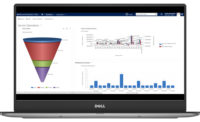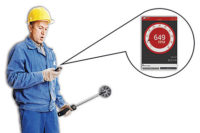HVAC contracting is in a unique position at this point in time. Technology is advancing not only on the equipment side but on the business side as well. There are various software platforms that allow contractors to monitor fleet management, inventory, invoices, payroll, customer service, field service management, and improve sales and customer experiences, just to name a few.
Whether contractors use one or all of these platforms, there’s a plethora to choose from.
The top three software categories include field service management, fleet management, and AutoCAD software. The NEWS talked to a few contractors who utilize software on a daily basis to narrow down their top choices and find out what features prove to be most useful.
FIELD SERVICE MANAGEMENT
Among all the software options, service management software is the No. 1 choice. Service management software allows a company to oversee how it provides services to its customers, including order management, hardware and software maintenance, diagnostics and troubleshooting, routine operations, etc.
This is most contractors’ go-to choice when trying to improve the way they run their business.
Think of service management technology as the one-stop shop for all of an HVAC business’s needs. Instead of an individual having to track each and every aspect of the business, the software does it for you. Need to know how long a technician was on the job? It’ll show you. Need replacement parts quickly and want to check inventories? It’s all in one place.
Also, because service management software allows employers to manage their business in real time, it ensures all employees are always on the same page.
“We switched to ServiceTitan after our server-based software crashed in our busiest time of year,” said Chris Hunter, president and co-owner, Hunter Heat & Air LLC, Ardmore, Oklahoma. “I knew I had to get everything in the cloud and not let that happen again. We had no data on where to even send our techs. Plus, every time we needed to make a change, we had to be at the office. Now, with ServiceTitan, we can run the business from anywhere and see what each technician’s key performance indicators (KPIs) are instantly.”
The ability to track KPIs is a major perk of using ServiceTitan software. Contractors can evaluate whether or not they are meeting company goals in various different areas, such as sales, customer service, and overall customer satisfaction.
ServiceTitan is helpful to both those in the office and the field. For the office, it has a CSR scorecard that can track call booking rates, KPIs, and performance, as well as a drag-and-drop scheduling and dispatching tool. Technician scorecards track KPIs and feature custom reporting options. For those in the field, the software includes a customer’s past inspections, unsold estimates, and invoices; mobile payments; a visual price book to show customers; and easy financing options for customers to view.
Additionally, the training process for employees is easy.
“ServiceTitan has a really good training platform,” said Hunter. “Techs and office people can go through the training modules and then test their skills.
“My favorite part is they have a ‘sandbox’ where you can go in and do anything you want inside the software without it affecting your real data,” he continued. “It’s a great way to learn how to use the functions.”
Butch Welsch, owner of Welsch Heating & Cooling Co., St. Louis, said Sawin Service Automation Inc. is his software of choice.
“We use Sawin, along with Microsoft Outlook, for some scheduling processes,” said Welsch. “We researched several companies before deciding on Sawin. It is used for inventory management, service dispatch, and all accounting needs. Sawin also offers continual training through support calls, and they host a user conference.”
Sawin is designed for service contracting firms seeking to track and improve performance, reliability, and scalability. Its features include service dispatch and mobile solutions; job cost, installation, and new construction templates; sales and marketing components; an accounting system; a multi-warehouse inventory control system; payroll hours tracked in real time; KPI reporting; secured sensitive files and software; and integration of products such as Microsoft Outlook, Word, Excel, and others.
FLEET MANAGEMENT
In addition to tracking metrics, it’s important to track your vehicles, too. Whether you have three trucks on the road or hundreds, it can become difficult to track when a technician is to arrive at a job site. Prior to fleet management, there was no way to identify this — contractors relied on the honesty policy over actual data. Now, GPS and power take off (PTO) monitoring makes it easier for contractors to track vehicles to avoid any discrepancies that may be coming from technicians and customers.
For example, let’s say your technician said he stayed for four hours on a job site, but the customer claims it was only two hours, and that’s all they’re paying for. Having the ability to pull up the data with GPS and see where the technician was and for how long allows the contractor to check the validity of the technician’s work hours. Also, PTO monitoring tracks how long the equipment is being used and to what extent. So, with both of these software platforms, a contactor can present a customer with actual data as to how long the technician stayed on the job site and how long the equipment was being used.
Another perk with fleet management software is that it can often be paired with field service management software.
Erik Knaak, vice president and general manager, Isaac Heating & Air Conditioning, Rochester, New York, chose his fleet management software for that exact reason.
“We use both Fleetmatics and Fleet Maintenance Pro,” said Knaak. “Fleetmatics for the GPS system was chosen based on a number of criteria with one major one being that it integrated with the Servman software to help create paperless payroll and call tracking.”
Fleet management software selection is a major decision, as it has to be integrated into an entire fleet of vehicles. Therefore, contractors seek software that is going to last for the long haul.
“Changing GPS providers would require almost 250 vehicles to be equipped with new equipment, so we always look at the return on investment (ROI),” said Knaak.
Fleetmatics provides real-time monitoring for more efficient dispatching, improved customer service, and reduced time spent calling drivers for updates. The fleet tracking app helps decrease costs by reducing speeding. It also increases sales by improving routing and dispatching, which allows for more customers to be served per day. Maintenance alerts inform contractors when their vehicles are due for maintenance and can be custom set based on calendar time, engine on-time, or mileage.
Fleet Maintenance Pro allows fleet inventory tracking, preventative maintenance, repair maintenance, history recording, fuel tracking, parts inventory, work orders, and flexible fleet reporting. The software provides tools to keep up to date on a fleet’s maintenance needs, preventing accidents, breakdowns, or other vehicle emergencies that prevent a technician from servicing a customer.
AUTOCAD
Auto computer-aided design (CAD) is computer-aided drafting software that is used for 2-D and 3-D drafting. Employees can use this software when designing any HVAC system or duct and piping system. It makes the drafting process and selling process much easier on contractors and technicians.
AutoCAD allows contractors to access the software remotely, share the drawings in the cloud, and includes a mobile app. There are innovative tools included that allow the user to attach or extract point cloud data; underlay building information modeling (BIM) designs; and import, plot, and attach PDFs.
Furthermore, utilizing this software allows one to create and communicate almost any design with 3-D modeling and visualization tools, so customers can get a virtual visual of what their HVAC system will look like to make any necessary changes before the project begins.
“We use AutoCAD to view drawings and make proposed changes to the customer,” said Elizabeth Gerner, general manager, Professional HVAC/R, Cleveland, Ohio. “Being able to submit the changes in drawing format to our customer has cut down on time trying to explain proposed changes.”
Similarly, AutoCAD is a great software program for those larger designs, such as in commercial projects.
“We use AutoCAD for design drafting within our commercial installation group for 2-D drafting,” said Knaak. “For training, depending on previous experience and schooling, it takes two to three months to become proficient and about one year to be fully capable on all elements of the suite.”
In addition to drafting, you can assign systems to equipment and ductwork as you draw and modify your design.
The newest features of AutoCAD include PDF import enhancements, external file references, object selection, and text to Mtext enhancements.







